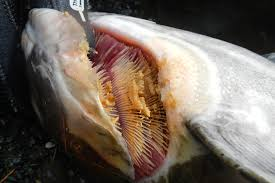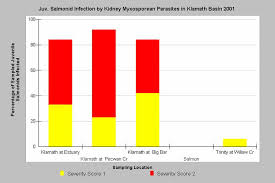From the Open-Publishing Calendar
From the Open-Publishing Newswire
Indybay Feature
Straight Talk About Klamath River Water and Salmon
A new government legal opinion that will help Klamath-Trinity salmon will do nothing to mitigate or end the high rate of salmon diseases in juvenile salmon migrating down the Klamath River. In 2014 100% of those juvenile fish were infected with diseases that are related to low flows and poor water qulaity. Three tribal governments are silent about these problems because they have agreed to a water deal which maximizes irrigation water diversion and delivery in the Upper Klamath River Basin in exchange for funding for tribal programs, economic development and "restoration" projects. But "restoration" is no substitute for the river flows salmon need. History will not look kindly on the tribal government leaders who made these deals.

There was good news in January for those who value and depend on Klamath River Salmon. Lawyers for the Department of Interior came out with a legal opinion finding that Humboldt County's right to 50,000 acre feet of the water stored behind Trinity Dam is distinct from water designated to sustain Trinity River fisheries when the dam was built. The US Bureau of Reclamation, part of the Interior Department, had claimed the opposite. That allowed them to divert more water from the Trinity River and ship that water to corporate farms far to the south in the San Joaquin Valley.
If followed by the US Bureau of Reclamation, the legal opinion should make more water available to prevent unnatural die-offs of Klamath-Trinity Salmon. But as Hoopa Fisheries chief Mike Orcutt has pointed out, using Trinity water to mitigate for inadequate flows and terrible Klamath River water quality is not a solution. For one thing, Trinity water releases will not prevent juvenile salmon migrating through the Klamath River to the Pacific Ocean from contracting fish diseases which are related to poor water quality and low river flows. Scientists and government reports confirm what has been hidden from most citizens: In 2014 100% of the juvenile Chinook salmon migrating down the Klamath River were diseased. Similar high disease rates occur in every dry year. Biologists tell us these fish may or may not die as juveniles but that they are less likely than healthy salmon to survive long enough to return, as adults, to spawn in Klamath tributaries.
Why is it that the yearly tragedy of Klamath River juvenile salmon disease and mortality is not reported in the media? And why is it that the self-proclaimed defenders of Klamath Salmon - the Yurok and Karuk Tribal Governments - whose leaders have claimed that for their peoples "salmon is everything" are not bringing this information out and taking action to address Klamath's salmon-killing river flows and terrible water quality?
In essence, the Yurok and Karuk Tribal Governments have become docile in the face of ongoing Klamath outrages because they agreed in the 2010 KBRA Water Deal to support the Bureau of Reclamation's management of Klamath River water. Reclamation manages Klamath water to maximize diversion and delivery of irrigation water. Under the KBRA the Klamath River gets minimum flows barely sufficient to prevent ESA-listed Coho salmon from going extinct and a promise of higher spring flows when and if there is water in excess of irrigation demand.
These tribes have also become increasingly dependent on funding from the US Bureau of Reclamation to run their fisheries and restoration departments and projects. If these tribal governments were to anger Reclamation managers that funding could and would be cut off. In essence, it is jobs and government funding which help make Karuk and Yurok leaders docile in the face of ongoing threats to salmon.
To make matters worse, the Upper Basin's Klamath Tribes more recently agreed to give up their claim to Klamath River flows for salmon below Upper Klamath Lake if the feds come up with money to buy land and for economic development projects. The Klamath Tribes' leaders want to get into the timber business and they are willing to give-up their right to Klamath salmon flows if the feds will finance their business plans.
So are Yurok, Karuk and Klamath tribal government leaders selling out Klamath salmon? Each of us must judge the situation for herself. My personal opinion is that, like all of us, tribal leaders have rationalized their positions and truly believe they are acting in the best interest of the River and Klamath Salmon. Like many other tribal governments across the West, restoration organizations and even some environmental groups, these leaders have bought the idea that funding for "restoration" can substitute for water, for the river flows needed to restore salmon to abundance.
History will show that the idea that we can starve a river of flows, providing only enough to keep fish from going extinct, and that everything will be OK because we are spending a few million dollars each year on "restoration" is hogwash. Unfortunately, by then it will likely be too late for Pacific Salmon.
Where they have water rights related to fisheries, federal tribes have a right to river and stream flows sufficient to restore fisheries to the point where they can provide a moderate living for the tribal folk who depend on them. Across the West, however, the right to restoration flows is being negotiated away by tribal government leaders in exchange for funding for tribal programs, infrastructure and "restoration". Historians will look back at these water deals as the second great rip-off of the American West's Indigenous natives: first they took the land and tried to "exterminate" the people; now, with the acquiescence of tribal government leaders, they are taking the water for the modern equivalent of a fistful of beads.
History will not look kindly upon the tribal government leaders who made these Faustian water deals.
If followed by the US Bureau of Reclamation, the legal opinion should make more water available to prevent unnatural die-offs of Klamath-Trinity Salmon. But as Hoopa Fisheries chief Mike Orcutt has pointed out, using Trinity water to mitigate for inadequate flows and terrible Klamath River water quality is not a solution. For one thing, Trinity water releases will not prevent juvenile salmon migrating through the Klamath River to the Pacific Ocean from contracting fish diseases which are related to poor water quality and low river flows. Scientists and government reports confirm what has been hidden from most citizens: In 2014 100% of the juvenile Chinook salmon migrating down the Klamath River were diseased. Similar high disease rates occur in every dry year. Biologists tell us these fish may or may not die as juveniles but that they are less likely than healthy salmon to survive long enough to return, as adults, to spawn in Klamath tributaries.
Why is it that the yearly tragedy of Klamath River juvenile salmon disease and mortality is not reported in the media? And why is it that the self-proclaimed defenders of Klamath Salmon - the Yurok and Karuk Tribal Governments - whose leaders have claimed that for their peoples "salmon is everything" are not bringing this information out and taking action to address Klamath's salmon-killing river flows and terrible water quality?
In essence, the Yurok and Karuk Tribal Governments have become docile in the face of ongoing Klamath outrages because they agreed in the 2010 KBRA Water Deal to support the Bureau of Reclamation's management of Klamath River water. Reclamation manages Klamath water to maximize diversion and delivery of irrigation water. Under the KBRA the Klamath River gets minimum flows barely sufficient to prevent ESA-listed Coho salmon from going extinct and a promise of higher spring flows when and if there is water in excess of irrigation demand.
These tribes have also become increasingly dependent on funding from the US Bureau of Reclamation to run their fisheries and restoration departments and projects. If these tribal governments were to anger Reclamation managers that funding could and would be cut off. In essence, it is jobs and government funding which help make Karuk and Yurok leaders docile in the face of ongoing threats to salmon.
To make matters worse, the Upper Basin's Klamath Tribes more recently agreed to give up their claim to Klamath River flows for salmon below Upper Klamath Lake if the feds come up with money to buy land and for economic development projects. The Klamath Tribes' leaders want to get into the timber business and they are willing to give-up their right to Klamath salmon flows if the feds will finance their business plans.
So are Yurok, Karuk and Klamath tribal government leaders selling out Klamath salmon? Each of us must judge the situation for herself. My personal opinion is that, like all of us, tribal leaders have rationalized their positions and truly believe they are acting in the best interest of the River and Klamath Salmon. Like many other tribal governments across the West, restoration organizations and even some environmental groups, these leaders have bought the idea that funding for "restoration" can substitute for water, for the river flows needed to restore salmon to abundance.
History will show that the idea that we can starve a river of flows, providing only enough to keep fish from going extinct, and that everything will be OK because we are spending a few million dollars each year on "restoration" is hogwash. Unfortunately, by then it will likely be too late for Pacific Salmon.
Where they have water rights related to fisheries, federal tribes have a right to river and stream flows sufficient to restore fisheries to the point where they can provide a moderate living for the tribal folk who depend on them. Across the West, however, the right to restoration flows is being negotiated away by tribal government leaders in exchange for funding for tribal programs, infrastructure and "restoration". Historians will look back at these water deals as the second great rip-off of the American West's Indigenous natives: first they took the land and tried to "exterminate" the people; now, with the acquiescence of tribal government leaders, they are taking the water for the modern equivalent of a fistful of beads.
History will not look kindly upon the tribal government leaders who made these Faustian water deals.
For more information:
http://klamblog.blogspot.com/
Add Your Comments
We are 100% volunteer and depend on your participation to sustain our efforts!
Get Involved
If you'd like to help with maintaining or developing the website, contact us.
Publish
Publish your stories and upcoming events on Indybay.
Topics
More
Search Indybay's Archives
Advanced Search
►
▼
IMC Network



